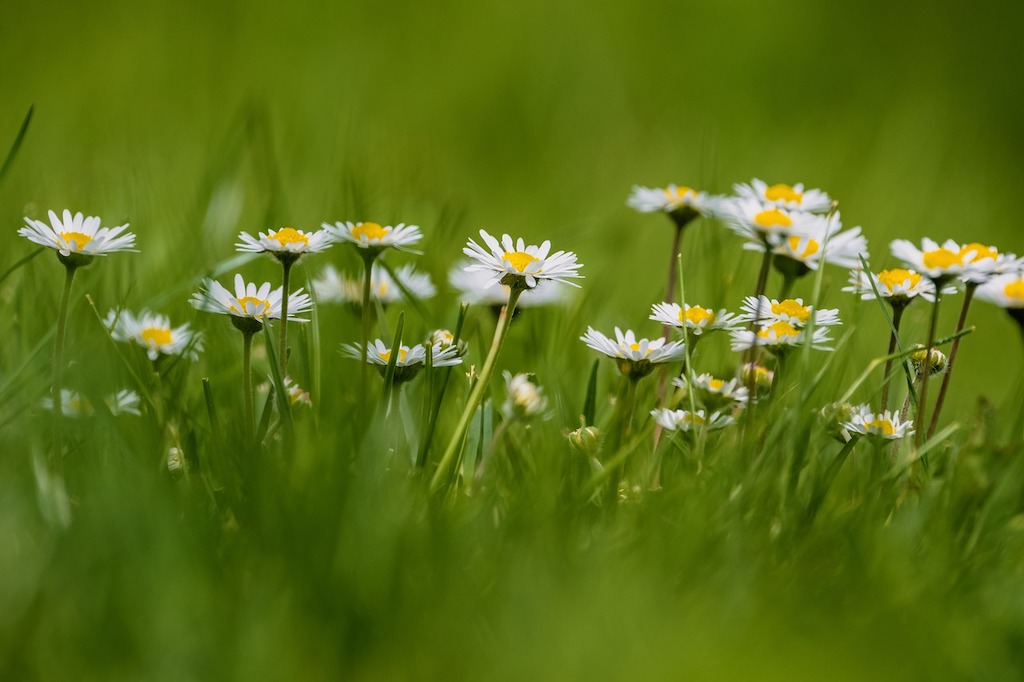
Foraging Daisy (Bellis perennis)
The dainty Daisy is a picture of innocence: it seems to have been made for adorning children’s heads. But there is a lot more to these lovely little flowers than meets the eye.
Etymology
The English name ‘Daisy’ means ‘Day’s Eye’ because the Daisy opens its flower head in the morning and closes it at night.
But the origin of its Latin name is a lot more surprising and somewhat controversial. Bellis means ‘pretty’ – an obvious choice for this little herb. But Mrs Grieves thinks it may have been named after a dryad known as Belidis. Another common name is ‘Baldur’s Brow’, linking the Daisy to the Norse Sun God Baldur. Another association links it to Bellona, a Goddess of war. Judging only by its appearance, this suggestion seems improbable, but its traditional medicinal uses give a deeper insight.
Properties of Daisy
Daisies first appear around the Spring Equinox, when the Sun enters Aries, which is ruled by Mars. The ancient herbalists used Daisy as a vulnerary – an herb to treat wounds, and as an anti-inflammatory and diaphoretic, for treating fevers. Inflammation, fever, and wounds all suggest a ‘Martian’ connection.
Mars also leaves its signature on the taste sensation. The leaves and roots are quite astringent, almost hot, but very unlike the heat of chillies. Instead, it is a spreading, radiating warmth, not a blistering burn.
The leaves are a little rough and moist, and have a demulcent quality. The old herbalists found Daisy’s heat suitable for treating conditions characterized by retracted, cold phlegm. Daisies loosen congestive conditions caused by an excess of cold moisture -as the ancient herbalists would put it.
Modern clinical herbalists have all but forgotten the pretty English Daisy. They use her sister, the Ox-Eyed Daisy, instead. Both can be used for similar complaints. Ox-Eyed Daisies are an excellent remedy for chronic bronchial conditions, asthma, and whooping cough. It is also used to treat nervous excitability and, prepared as a lotion or ointment, as a wound herb.
Wild herbs are not only nutritious but also therapeutic – and none more so than the early spring herbs. They often provide just what our bodies need to restore vitality after fending off winter bugs.
Daisy as Wild Food
Recipes
Daisy in the Salad:
Daisy leaves and flowers can be added to spring salads. The young, tender leaves are rich in vitamin C, and their heat produces a diaphoretic effect.
Daisy Capers:
Conventional Capers are made from the unopened flower buds of the caper tree (Capparis spinosa.) But inventive foragers use the same method on other flower buds, such as Daisies or Dandelions (only use edible flowers!)
The basic recipe is quite simple:
Pick about one cup of Daisy buds, wash, and cover them with about 500 ml of salted water. Quickly bring to a boil and strain through a cheesecloth or finely meshed strainer.
Place the buds into a stone jar and pour 500 ml of boiling vinegar over them.
Make sure they are completely covered.
After about 4-5 days, pour the buds and vinegar into a pan and, making sure the buds are covered, bring to a boil.
Let them cool, jar and cover with jam cling film to prevent the buds from coming into direct contact with the air and turning mouldy.
Daisy Soup:
Daisy soup is quick and easy to prepare and can be made at almost any time of the year. Use all parts of the plant: roots, leaves and flowers. (Only use the roots if Daisies are prolific in your area.) Picking the plants is easy, but if you have heavy clay soil, be prepared for clots of dirt to cling to the roots, making cleaning them tedious.
Pick about 6-8oz of flowers (roots, leaves and tops), clean well and chop them up (not too small).
Quickly sauté them in a heavy pan with a few drops of olive oil.
Add half a cup of white wine or apple cider, let the alcohol fly off, and stir in 1 litre of vegetable broth. Season to taste and finish off with a dash of cream. Serve with croutons.
#Ads
Disclosure: As an Amazon Associate, I earn from qualifying purchases.


